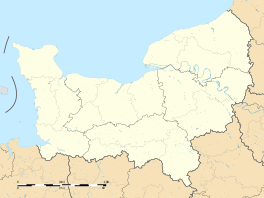Bénouville, Calvados
| Bénouville | ||
|---|---|---|
| Commune | ||

Chateau of Bénouville
|
||
|
||
| Coordinates: 49°14′30″N 0°16′43″W / 49.2417°N 0.2786°WCoordinates: 49°14′30″N 0°16′43″W / 49.2417°N 0.2786°W | ||
| Country | France | |
| Region | Normandy | |
| Department | Calvados | |
| Arrondissement | Caen | |
| Canton | Ouistreham | |
| Intercommunality | Caen la Mer | |
| Government | ||
| • Mayor (2008–2014) | Alain Lepareur | |
| Area1 | 5.28 km2 (2.04 sq mi) | |
| Population (2008)2 | 1,946 | |
| • Density | 370/km2 (950/sq mi) | |
| Time zone | CET (UTC+1) | |
| • Summer (DST) | CEST (UTC+2) | |
| INSEE/Postal code | 14060 /14970 | |
| Elevation | 1–50 m (3.3–164.0 ft) (avg. 30 m or 98 ft) |
|
|
1 French Land Register data, which excludes lakes, ponds, glaciers > 1 km² (0.386 sq mi or 247 acres) and river estuaries. 2Population without double counting: residents of multiple communes (e.g., students and military personnel) only counted once. |
||
1 French Land Register data, which excludes lakes, ponds, glaciers > 1 km² (0.386 sq mi or 247 acres) and river estuaries.
Bénouville is a commune in the Calvados department in the Normandy region in northwestern France.
It is located on the Canal de Caen à la Mer close to Caen and Ouistreham.
Bénouville was the scene of the first - and possibly most vital - battle of the Allied invasion of Europe on D-Day, 6 June 1944 and the night before. From 12.15 am (British Double Summertime = 23:15 German/Middle-European time), a reinforced company of glider-borne troops from the 2nd Batt. Oxfordshire and Buckinghamshire Light Infantry, led by Major Reginald John Howard, landed around the bridge over the Caen Canal at Bénouville in three Horsa gliders and captured it from the Germans in a swift and dramatic attack. Control of this bridge was vital to the success of the whole Operation Overlord invasion, because it would be the route of any German counter-attack eventually with their "Panzers" against the seaborne forces which were due to start landing a few hours later on Sword.
At the same time, another Oxfordshire and Buckinghamshire glider-borne force of sixty men (one glider was wrongly released near Varaville at the Dives River) captured the neighbouring bridge over the River Orne - about a quarter of a mile away near Ranville - which was also of vital strategic importance. The Caen Canal bridge was later renamed Pegasus Bridge by Royal Engineers, in honour of the winged horse symbol of the Airborne Forces, while the River Orne bridge was many years later renamed Horsa Bridge, after the type of glider which carried the men to war.
Today, Pegasus Bridge and the nearby Gondrée Café are the scene of many pilgrimages and commemoration ceremonies, particularly around 6 June. Its wartime inhabitants were members of a local resistance group and passed information on the canal bridge unto a cell in Caen and from there to England. A few hundred yards across Pegasus Bridge lies the modern Musée Mémorial Pegasus. As for the Café Gondrée, on D-Day itself Monsieur and Mme Gondrée who lived in the café were woken up by the landing of the gliders. Monsieur Gondrée looked out of a window and saw black 'masked' troops running over the bridge, which he later learned were British paratroopers. In celebration, he also dug up some 99 bottles of champagne which he had hidden in the garden and in the morning of 6 June toasted his liberation with some of the men from the gliders.
...
Wikipedia



